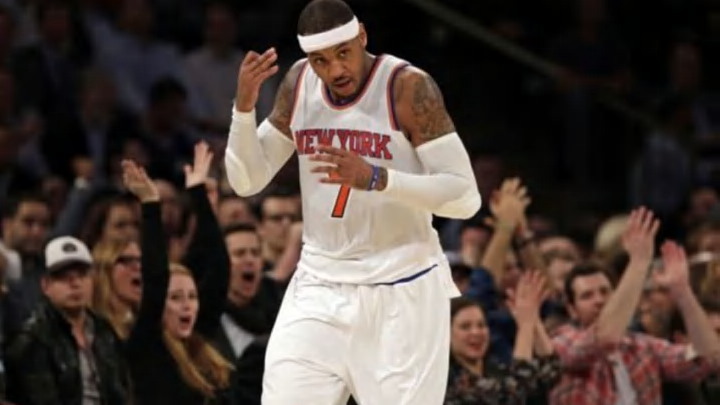Carmelo Anthony has struggled by his standards thus far this season. At age 31 and coming off offseason knee surgery, how well will Melo age?
We’ve all heard the old adage. “Father Time is undefeated.”
We’ve all witnessed it firsthand — where immortal specimens hit their athletic expiration date, and their game, as well as production, falls off a proverbial cliff.
The decline is a ticking time bomb; everyone expects it to happen, but when it does, it still sends shockwaves to their allegiance of fans as they ponder where the time had gone.
ALSO ON HOOPSHABIT: The Top 30 Ball-Handlers of All-Time
For New York Knicks star Carmelo Anthony, injuries, age and natural wear-and-tear have caused the 6’7″ brute forward to endure perhaps his worst individual season since his second year in the league.
As a 31-year-old volume scorer coming off of offseason knee surgery — not to mention, he’s also inconspicuously accumulated over 33,000 career minutes (regular season and playoffs) as he plays in his 13th NBA campaign — many pundits are questioning whether Melo will ever regain his peak form of years past.
At present, Anthony is averaging 21.7 points per game while shooting 43.4 percent from inside the arc and an effective field goal percentage of 45.7 percent — posting his lowest anecdotal output and scoring efficiency since 2004-05.
More from New York Knicks
- NBA Trades: This swing-for-the-fences deal is a must for the Knicks
- Ranking Leon Rose’s three best and worst moves as Knicks President
- New York Knicks: Why Julius Randle is essential for the Knicks
- Should the Knicks trade up into the first round of the 2023 NBA Draft?
- Knicks 2023 offseason primer: free agents, trades, draft needs and more
In addition, his advanced metrics across the board, from his Player Efficiency Rating to true shooting percentage, have congruently dipped to a 12-year low.
Upon entering the league in 2003, Carmelo had always been considered as one of the most skilled and versatile scorers the NBA had to offer. A classic “matchup-nightmare,” Anthony had the rare concoction of skills to score seemingly at will whenever he was isolated on the wings.
If a smaller defender was on him, the former Syracuse Orangemen would use his blinding first step and city ball strength to bully his man all the way to the basket and finish with his unanticipated brand of explosiveness. Conversely, when facing a bigger defender, Melo had the handle and finesse game to dance out on the perimeter before delivering his patented stop-on-a-dime pull-up.
With range trickling out to 25-feet and beyond, peak Anthony — specifically, from 2012-14 — even if his style of play (midrange heavy and a lot of contested twos) inherently went against the grain of modern analytics and contemporary efficiency principles, was still as unstoppable of a scoring force as anyone in the association.
However, Melo’s game is clearly changing, self-mindfully or not.
He has clearly lost a step. Most noticeably, his bounce has deteriorated and his first step is not nearly as devastating. He’s pump-faking more than ever whenever he intrudes the paint, a common sign of depreciating athleticism.
Not surprisingly, he’s converting on only 49.5 percent of his field goal attempts from three feet and in, nearly 10 percentage points below his career average.
More alarmingly, Melo is only making 37.0 percent of pull-up forays — his bread and butter, and an avenue of offense that accounts for over 41.8 percent of his shot attmpts.
So, where does Carmelo Anthony go from here?
His days as the team’s 1A and 1B option are most likely over; but as someone who never really over-relied on his athletic gifts, Anthony’s game should theoretically age rather gracefully — think a bigger Paul Pierce.
To successfully unearth the second phase of his career arc, though, Melo must swallow his pride and take on a more team-oriented approach and complementary role.
No doubt, he’s still one of the league’s most effective and stress-inducing isolation players — currently ranking within the top 67-percentile, producing over 0.97 PPP (points per possession) when isolated, which consumes nearly 27 percent of his offensive touches.
However, as his skills continue to somewhat gradually diminish, Melo’s isolation aspirations needs to be modestly and judiciously tempered.
A permanent move to the 4 should also help preserve Anthony’s effectiveness, allowing him to revive some of his advantages in foot speed he had on 3s during his prime. Carmelo has also quietly built a nice rapport with the Knicks’ prized rookie, Kristaps Porzingis; however, the pick-and-roll/pick-and-pop has always played an underutilized role in the triangle offense.
Most optimistically, despite his dire scoring output (when compared to his historical production), Anthony is posting an assist percentage, defensive rebounding percentage, and overall rebounding percentage that exceeds his career averages.
Additionally, Melo has noticeably increased his fervor and effort on the defensive end of the floor. In fact, opponents are only shooting 34.6 percent on Anthony, 9.6 percent lower than what they usually shoot.
All in all, while it’s en vogue to overreact and prematurely proclaim the complete demise of Carmelo Anthony, he should age quite modestly once he fully finds his footing from his knee surgery.
Next: Every NBA Team's Star Wars Counterpart
Although his days as a top-10 player are over, from his ability to still score in isolation, to his refined auxiliary skills; from his established “grounded” game, to his refocused defensive intensity; Melo should continue to be a net positive if — and only, if — he accepts a lessened offensive load.
